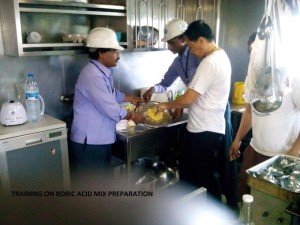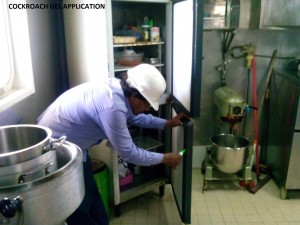

Ship Sanitization
Inspection on board vessel
Identification of pests & level of infestation
Identification of structural deficiencies
Preparing course of action in line with guidelines of WHO & IHR 2005
Training the crew members on IPM and effective cockroach management without using chemicals
Training the crew members on proper use of rat guards
Training the crew members on proper placement of rodent baits
Pest management operations as per the designed course of action
Issuance of work completion certificate
Follow up
Historically, ships have played a significant role in the global transmission of infectious disease. Some of the earliest recorded evidence of attempts to control human disease transmission via ships dates to the 14th century, when ports denied access to ships suspected of carrying the plague. In the 19th century, the spread of cholera pandemics was thought to have been facilitated by merchant shipping. A World Health Organization (WHO) review identified more than 100 disease outbreaks associated with ships between 1970 and 2003 (Rooney et al., 2004).
Today’s world fleet of propelled seagoing merchant ships of more than 100 billion tonnes comprises 99 741 ships, with an average age of 22 years, registered in more than 150 nations and crewed by more than a million seafarers of virtually every nationality.
Ships can have significance to public health beyond their role in ship acquired infection. For example, ships can transport infected humans and other vectors, such as mosquitoes and rats, between ports and can therefore act as a means of national and international dissemination of disease and disease agents.



More than 100 outbreaks of infectious diseases associated with ships were reported between 1970 and 2003 (Rooney et al., 2004). Reported outbreaks included legionellosis, influenza, typhoid fever, salmonellosis, viral gastroenteritis (e.g. norovirus), enterotoxigenic Escherichia coli infection, shigellosis, cryptosporidiosis and trichinosis. Naval ships, cargo ships, ferries and cruise ships were all affected, often with serious operational and financial consequences.
If proper control measures are not in place, ships are particularly prone to disease outbreaks. Ships contain isolated communities with close accommodations, shared sanitary facilities and common food and water supplies. Such conditions can be favourable to the spread of infectious diseases. The inevitable publicity that comes along with a Guide to ship sanitation disease outbreak on board can have a serious financial impact on the ship owners and those relying on use of the ship for transport or leisure.
HENCE THE IMPORTANCE OF DISINFESTATION OF SHIPS WHILE BERTHING.
WE CONDUCT DISINFESTATION SERVICES (DE-RATTING, COCKROACH MANAGEMENT, OTHER CRAWLING & FLYING PESTS) ON BOARD VESSELS, AS PER THE GUIDELINES OF “WHO “ & IHR 2005.

We introduce ourselves as a professionally managed Pest Management & Fumigation Agency comprising of Technically qualified & Certified expertise people with most advanced equipments
+91 80002 00008,
+91 9825221253
rn@sensationgroupindia.com
opn@sensationgroupindia.com
Office Number 21, 2nd Floor, Goyal Avenue, P. No. 318, 12/B, Gandhidham. Kutch. Guj - 370201
Copyright by SPC – 2024. Designed By SOLITS
WhatsApp us